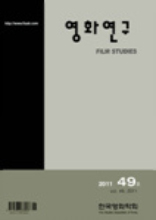- 영문명
- The Status and role of a rat in 'The Housemaid': A Study of the critical reconsideration on 'the myth of Kim Ki-young'
- 발행기관
- 한국영화학회
- 저자명
- 박우성
- 간행물 정보
- 『영화연구』제49호, 61~92쪽, 전체 32쪽
- 주제분류
- 예술체육 > 예술일반
- 파일형태
- 발행일자
- 2011.09.30
6,640원
구매일시로부터 72시간 이내에 다운로드 가능합니다.
이 학술논문 정보는 (주)교보문고와 각 발행기관 사이에 저작물 이용 계약이 체결된 것으로, 교보문고를 통해 제공되고 있습니다.

국문 초록
영문 초록
As is generally known, Kim Ki-young's (1960) has high status in Korean film history. When the film was released, however, it didn't receive much attention by critics compared to other films at the time. As it encountered theoretical framework of postmodernism, it started to be revalued. In that sense, there is no doubt that transcends the ages. What matters is that recent discussion over the film in accordance with the postmodernist theoretical framework could be blamed for applying present perspective to the past unilaterally. In other words, the discussion is so abstract without sociocultural contents at the time. So it can't even explain why the film did well at the box office when released. Therefore, this study is based on the idea that this film is an output of certain sociocultural contents as well, and focuses on the rat in the film which reveals effectively its connection with social context. In the 1960s, Korea began its modernization project, led by the government. Rats became considered as an outdated symptom by the process, distinct from modern creature. As such nature of a rat meets the housemaid, modern and premodern concepts coexist in the film. But this kind of approach has a risk to treat the film just as an object reflecting society. Thus this study also tries to look at the way of the rat being concretely embodied in the film. Unlike the postmodernist view, uses a clear and direct directing strategy to embody 'a rat-human being'. And the strategy makes deep structures through the whole film to bring out premodern fear effectively. In this way, it can be proved that is not a film transcending the ages, but the output of contemporary conditions. Furthermore, it leads to the necessity of a critical reconsideration on the so-called 'myth of Kim Ki-young' which has been abstractly established by postmodernist theoretical framework. It's undeniable that Kim Ki-young is a genius. But it's because he stretched his cinematic imagination within the time he lived in, not because he was advanced for his time. The problem is his perception of the times was not far from the national discourse. That is, while his film recognized the times exactly, it didn't go further to throw a doubt on the structure of the spirit of the times. It means is not a film ahead of his time.
목차
1. 포스트모더니즘 이론모형
2. ‘쥐-인간’으로서의 정체성
3. ‘하녀=쥐’라는 도식의 구축
4. 쥐라는 장치의 사회문화적 위상
5. 탁월한 동시대적 감각
6. 김기영 감독과 <하녀>의 좌표
키워드
해당간행물 수록 논문
참고문헌
관련논문
예술체육 > 예술일반분야 BEST
- 생성형 AI 도구와 디자이너의 협업 프로세스 개발 - 이미지를 통한 아이디어 확산에서 고해상도 렌더링까지
- ‘일과 삶의 균형(Work-Life Balance)’ 척도 개발을 위한 연구
- 디자인 전공 교과목에서의 생성형 AI 도구 활용 사례 연구
예술체육 > 예술일반분야 NEW
- 한국영화의 촬영과 조명 시리즈 2: 영화 '형사, Duelist'의 Visual Concept 및 조명플랜
- 포스트모더니즘적 영상표현에 관한 연구 -실사 영화와 애니메이션 영화의 상호작용을 중심으로-
- 소니 HVR-Z1N 카메라의 중요한 메뉴에 관한 소고
최근 이용한 논문
교보eBook 첫 방문을 환영 합니다!

신규가입 혜택 지급이 완료 되었습니다.
바로 사용 가능한 교보e캐시 1,000원 (유효기간 7일)
지금 바로 교보eBook의 다양한 콘텐츠를 이용해 보세요!



